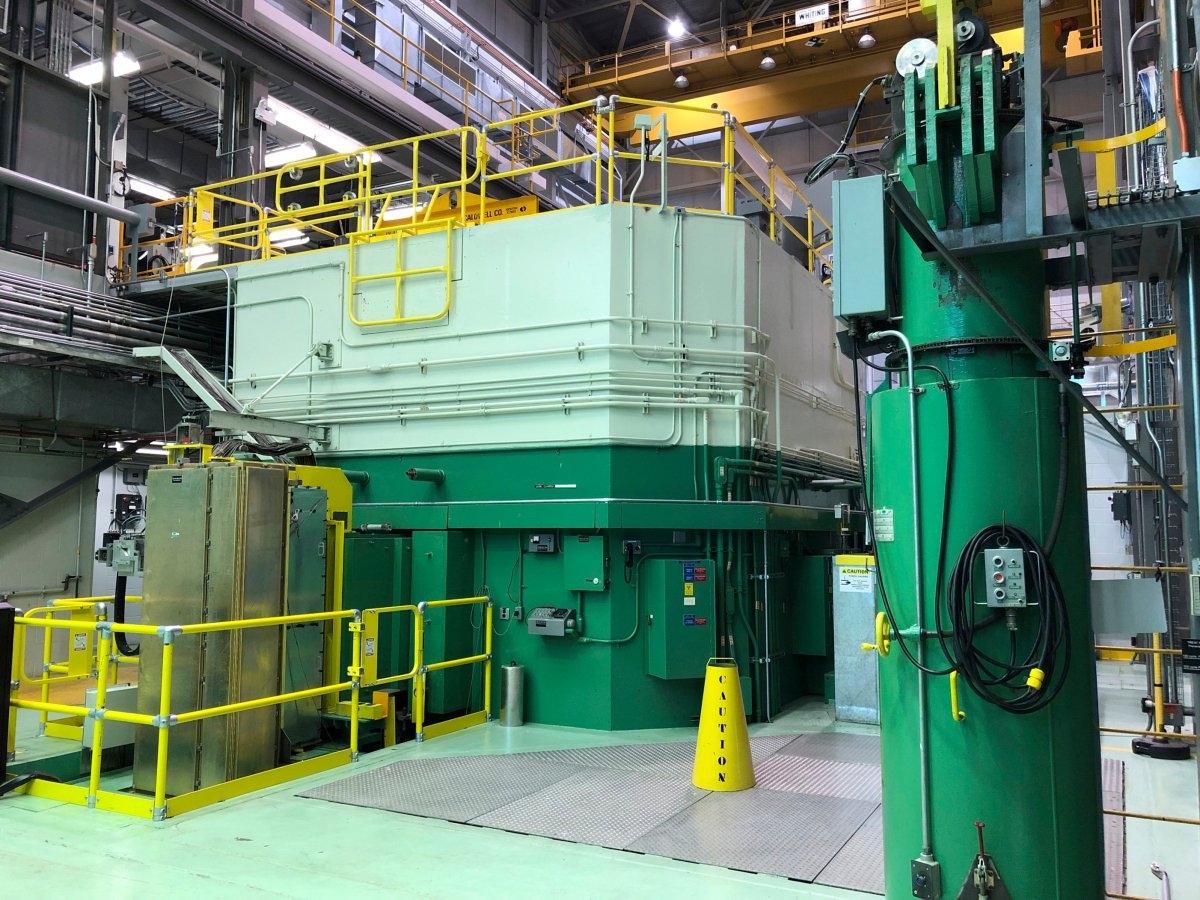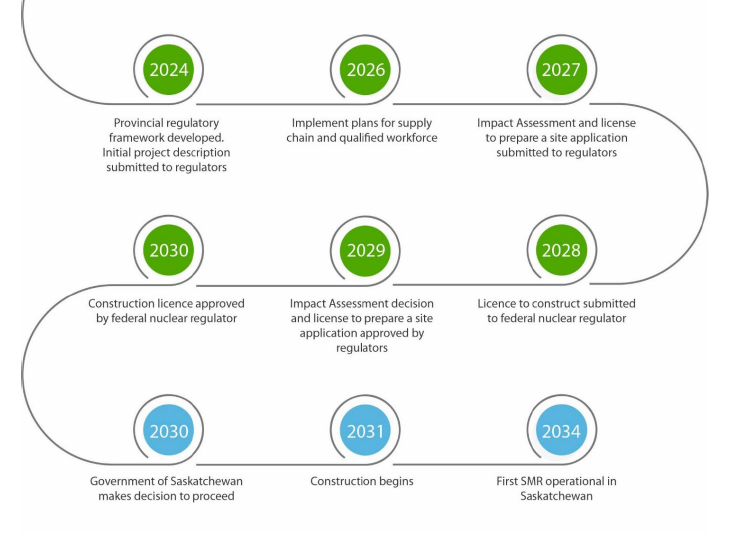The Saskatchewan provincial government, along with the governments of Ontario, New Brunswick and Alberta, has announced a strategic plan outlining a path towards the use of small modular nuclear reactors (SMRs), which it hopes can advance SaskPower’s goal of achieving net-zero greenhouse gas emissions by 2050.

Currently, 76 per cent of electricity in Saskatchewan is generated by fossil fuels, according to the province.
“Saskatchewan will not make a final decision on whether it will be building an SMR for several years but SaskPower has been working diligently on planning work to help inform that decision,” SaskPower Minister Don Morgan said at a Monday morning press conference.
“SMR technology has the potential to help our economy grow and prosper while contributing to efforts to reduce greenhouse gas emissions.”
While in its very early stages, the plan suggests Saskatchewan could be producing as much as 1200 megawatts (MW) of nuclear power by the year 2042, with an initial 300 MW reactor under construction by 2030 and operational by 2034.
Possible locations of where the reactors would operate have yet to be identified by the province.
During the conference it was noted that a small reactor would cost around $5 billion, and so the energy ministers are looking into different ways of generating funding for the initiative.
SMRs are scalable nuclear reactors that typically produce 300 MW of electricity or less, according to a provincial news release on the subject. They can support large established power grids, small grids, remote off-grid communities and resource projects.
The smallest-scale “micro SMRs” can be small enough to fit in a shipping container, industry professionals at the Monday conference said.
Asked how big a role 1200 MW of nuclear energy could play in satisfying future energy demands in Saskatchewan, including an increase in uptake of electric vehicles, Morgan said the province will require multiple forms of clean energy production to hit emissions targets while meeting need.
- B.C. officer alleged sexual assault, CSIS had her investigated
- Alberta to overhaul municipal rules to include sweeping new powers, municipal political parties
- Military judges don’t have divided loyalties, Canada’s top court rules
- Norad looking to NATO to help detect threats over the Arctic, chief says
“We’d also be open to looking at a variety of options to providing base load power for the province,” Morgan stated.
“We’ve not ruled out any particular technology. We’ve got solar and wind, but as you’re aware, those do not provide base load power, but we’re looking at every option that’s there,” he explained.
Morgan said the provinces are planning for the 2050 target and will be conducting negotiations and discussions with the federal government.
When asked about the safety of the technology on Monday, Canadian Nuclear Association CEO John Gorman said “a lot of misinformation and stigma” surrounds the nuclear industry, especially following incidents like the one that occurred in Fukushima.
Gorman calls it “one of the safest, if not the safest, forms of electricity generation on earth”.
“There’s a lot of fears that aren’t based on science and fact. That being said, this next generation of nuclear reactors have advanced and enhanced safety features including failsafe systems that don’t require any human intervention at all, they just rely on physics to shut down and shut off,” he added.
Gorman also said nuclear waste can be safely transported by truck, due to its small size and strict regulations enforced by the Nuclear Waste Management Organization.
Gorman maintains that uranium is “about a million times more energy-dense than coal.”
“For any of us the amount of uranium it would take to power our entire lives, electricity, transportation, homes and everything, would fit inside a Coke bottle,” Gorman told reporters.
The intergovernmental plan announced on Monday notes the potential of permanently storing nuclear waste generated in all provinces in one central “deep geological repository (DGR)” and states that two communities in Ontario are being actively considered as potential DGR sites.
However, the plan does not specify which communities are being considered.
Cameco Corporation Government Relations Director Jeff Hryhoriw said the technology has the potential to “open up new markets and expand existing markets” for the nuclear energy industry in Saskatchewan and Canada.
“Going forward we see more demand for the uranium fuel products we produce should these technologies advance through to commercial application. But any increase in demand is going to be a net-positive for Cameco and a net-positive for northern Saskatchewan,” he said.
Hryhoriw called Cameco’s track record on addressing environmental concerns associated with mining “excellent”.
“The uranium deposits that are in the Athabasca basin can be as much as 100 times the global average ore rate,” he said.
Hryhoriw said this means a lot of uranium can be captured from moving smaller volumes of dirt and soil and rock.
According to a release sent out by the Saskatchewan government, the report identifies some key areas for SMR development and deployment.
The first is to position Canada as an exporter of global SMR technology by driving three separate streams of SMR development, which would cover both on-grid and off-grid applications.
Another key area in the report involves promoting a strong nuclear regulatory framework focusing on public health and safety, along with the environment, while ensuring reasonable costs and timelines are met.
Securing federal government commitments on financial and policy support for new SMR technologies leading to economic benefits and meeting Canadian emissions reduction targets is an additional key component of the plan.
They governments say this plan would also create job opportunities for participation from Indigenous communities and public engagement.
They add they will be engaging with Indigenous communities on the possibility of equity stakes. They say some consultation has already been done and the plan is to further that initial communication.
Additionally, the plan gives the federal government and nuclear operators an opportunity to work on a robust nuclear waste management plan for SMRs.
Since December 2019, Ontario, New Brunswick and Saskatchewan have been working together to further the use of SMRs in Canada through an inter-provincial Memorandum of Understanding (MOU). Alberta joined the MOU in April 2021.
The release also states the report builds on the provincial power utilities’ SMR Feasibility Study that was requested by the provinces as part of the MOU, which concluded SMR development can “support domestic energy needs, curb greenhouse gas emissions, and position Canada as a global leader in clean technologies and the fight against climate change.”
“I look forward to continued cooperation through our joint strategic plan as we make progress towards Canada’s first on-grid and off-grid SMR, both planned to be built in Ontario,” said Todd Smith, Ontario Minister of Energy.
In his statement, Minister Smith continues to say that the world is watching Canada when it comes to SMRs and that he’s confident the country’s reputation as a global hub for SMR expertise will only grow stronger from here.
“With job creators looking for affordable, reliable and clean energy, SMRs will enhance our clean energy advantage and help us secure new investments that will create jobs across our province,” Smith said.
“New Brunswick has a long history as a Canadian leader in the energy sector,” said Mike Holland, New Brunswick Minister of Natural Resources and Energy Development.
Holland said nuclear energy has been a key component of the New Brunswick energy landscape for almost 40 years and that its role in reaching net-zero emissions is well understood.
“It is encouraging to see the private sector get behind these initiatives to help position New Brunswick as a leader in advanced nuclear and clean energy development. This joint strategic plan represents an exciting step forward in energy innovation and I look forward to working with our partners across the country to continue this important work,” Holland added.
“Alberta is committed to responsible and innovative energy development,” said Sonya Savage, Alberta’s Minister of Energy.
Savage said there is potential for SMRs to provide zero-emission energy for industrial operations in remote areas and to reduce emissions from Alberta’s oil sands.
“This strategic plan marks another important step forward to determine how to best manage and regulate this innovative technology by working with our provincial partners and federal regulators,” Savage said.







Comments